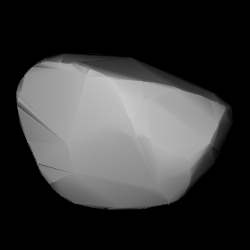Top Qs
Timeline
Chat
Perspective
5283 Pyrrhus
Asteroid From Wikipedia, the free encyclopedia
Remove ads
5283 Pyrrhus /ˈpɪrəs/ is a large Jupiter trojan from the Greek camp, approximately 65 kilometers (40 miles) in diameter. It was discovered on 31 January 1989, by American astronomer Carolyn Shoemaker at the Palomar Observatory in California.[1] The dark Jovian asteroid belongs to the 100 largest Jupiter trojans and has a rotation period of 7.3 hours.[9] It was named after Achilles son, Neoptolemus (also called Pyrrhus) from Greek mythology.[1]
Remove ads
Orbit and classification
Pyrrhus is a dark Jovian asteroid orbiting in the leading Greek camp at Jupiter's L4 Lagrangian point, 60° ahead of the Gas Giant's orbit in a 1:1 resonance .[3] It is also a non-family asteroid in the Jovian background population.[4] It orbits the Sun at a distance of 4.4–6.0 AU once every 11 years and 10 months (4,335 days; semi-major axis of 5.2 AU). Its orbit has an eccentricity of 0.15 and an inclination of 17° with respect to the ecliptic.[2] The body's observation arc begins with a precovery taken at Palomar in November 1951, or more than 37 years prior to its official discovery observation.[1]
Remove ads
Naming
This minor planet was named by the discoverer from Greek mythology after Achilles son Neoptolemus (see 2260 Neoptolemus) also known as Pyrrhus. His alternative name, Pyrrhus, origins from the red color of his hair. After his father's death, he was brought by Odysseus to the Trojan War, where he became the most ruthless of all the Greeks. He brutally killed King Priam and several other princes during the destruction of the city of Troy, and took away Hector's wife, Andromache, as his prize.[1] The official naming citation was published by the Minor Planet Center on 4 June 1993 (M.P.C. 22250).[10]
Remove ads
Physical characteristics
Summarize
Perspective
Pyrrhus is an assumed C-type asteroid, while most larger Jupiter trojans are D-type asteroids. It has a typical V–I color index of 0.95 (also see table).[9]
Rotation period
In September 1996, the first photometric observations Pyrrhus were obtained by Italian astronomer Stefano Mottola using the Bochum 0.61-metre Telescope at ESO's La Silla Observatory in Chile. The lightcurve however showed very little variation. Follow-up observation by Mottola at the Calar Alto Observatory with its 1.2-meter telescope in March 2002 gave a rotation period of 7.323±0.003 hours with a brightness amplitude of 0.11 magnitude (U=2).[8][9]
Diameter and albedo
According to the surveys carried out by the NEOWISE mission of NASA's Wide-field Infrared Survey Explorer, The Infrared Astronomical Satellite IRAS, and the Japanese Akari satellite, Pyrrhus measures between 48.36 and 69.93 kilometers in diameter and its surface has an albedo between 0.072 and 0.100.[5][6][7] The Collaborative Asteroid Lightcurve Link derives an albedo of 0.0564 and a diameter of 64.26 kilometers based on an absolute magnitude of 9.7.[9]
100+ largest Jupiter trojans
Remove ads
References
External links
Wikiwand - on
Seamless Wikipedia browsing. On steroids.
Remove ads

